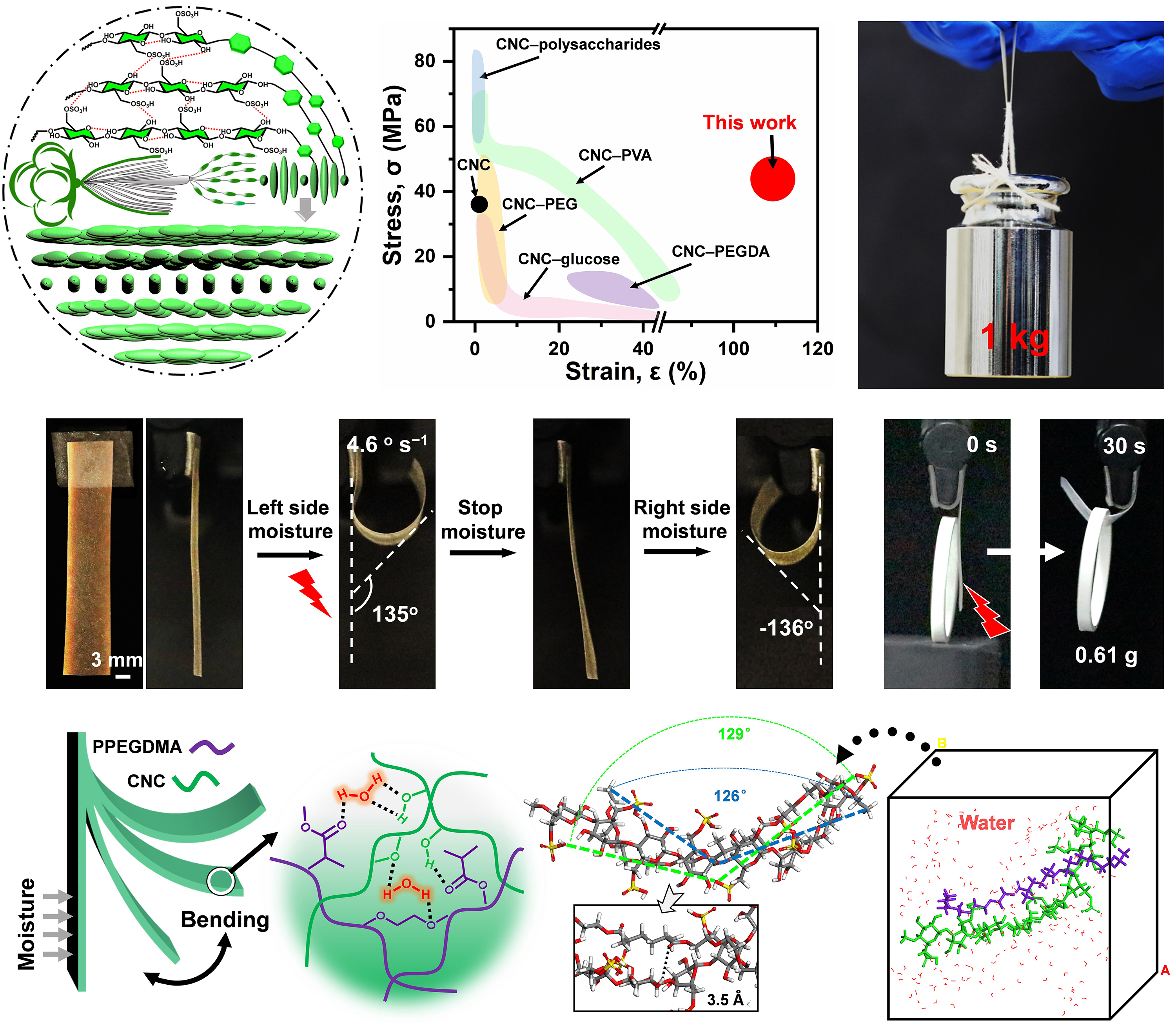我组(18T7组)在纤维素纳米晶体研究方面取得新进展。纤维素纳米晶体(CNC)衍生的光子材料在生产可再生光学器件和工程领域具有巨大潜力。然而,此类材料如何同时拥有韧性、强度和多种响应,用在开发高性能传感器、智能涂层、柔性纺织品和多功能设备,仍然具有挑战性。在这里,我们报告了一种简单而稳健的策略,即聚(乙二醇)二甲基丙烯酸酯(PEGDMA)在N,N-二甲基甲酰胺溶剂体系中紫外触发自由基聚合,从而嵌入到CNCs的手性向列结构中。获得的CNC-poly(PEGDMA)复合材料显示出令人印象深刻的机械强度(42 MPa)、拉伸性(104%)、韧性(31 MJm–3)和耐溶剂性。值得注意的是,该材料保留了生动的光子结构色,可以响应施加的机械刺激,表现为从红色、黄色到绿色的拉伸变色。更有趣的是,在暴露于喷雾水汽后,它会执行敏感的驱动(4.6°·s−1)和多种复杂的3D变形行为,并伴有协同的彩虹色外观。此外,由于CNC的各向异性结构(典型的左手螺旋),该驱动能够模仿盘绕的卷须,产生高概率(63%)的右手螺旋形状。我们设想这种具有可持续性、鲁棒性、机械致变色性和特定驱动能力的多功能系统将在机械传感器、可拉伸光学器件、智能驱动器和软机器人领域开辟一条可持续发展的道路。
相关成果发表在《Small》上,以上研究工作得到国家自然科学基金、我所创新特区组启动基金、兴辽英才计划等项目的支持。

Highly tough, stretchable, and solvent-resistant cellulose nanocrystal photonic films for mechanochromism and actuator properties
Wenna Ge, Fusheng Zhang,* Dongdong Wang, Quanmao Wei, Qiongya Li, Zhixin Feng, Shile Feng, Xingya Xue, Guangyan Qing,* and Yahua Liu*
Small 2022, 2107105. DOI: 10.1002/smll.202107105
Cellulose nanocrystals (CNCs)–derived photonic materials have confirmed great potential in producing renewable optical and engineering areas. However, it remains challenging to simultaneously possess toughness, strength, and multiple responses for developing high-performance sensors, intelligent coatings, flexible textiles, and multifunctional devices. Herein, the authors report a facile and robust strategy that poly(ethylene glycol) dimethacrylate (PEGDMA) can be converged into the chiral nematic structure of CNCs by ultraviolet-triggered free radical polymerization in an N,N-dimethylformamide solvent system. The resulting CNC–poly(PEGDMA) composite exhibits impressive strength (42 MPa), stretchability (104%), toughness (31 MJ m−3), and solvent resistance. Notably, it preserves vivid optical iridescence, displaying stretchable variation from red, yellow, to green responding to the applied mechanical stimuli. More interestingly, upon exposure to spraying moisture, it executes sensitive actuation (4.6° s−1) and multiple complex 3D deformation behaviors, accompanied by synergistic iridescent appearances. Due to its structural anisotropy of CNC with typical left-handedness, the actuation shows the capability to generate a high probability (63%) of right-handed helical shapes, mimicking a coiled tendril. The authors envision that this versatile system with sustainability, robustness, mechanochromism, and specific actuating ability will open a sustainable avenue in mechanical sensors, stretchable optics, intelligent actuators, and soft robots.